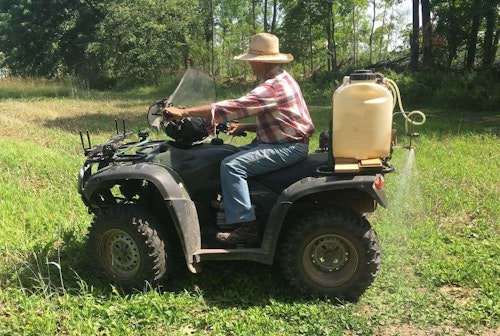
Whitetails love brassicas, especially during the fall hunting seasons. (Photo from Whitetail Institute Facebook.)
Thus far during summer 2021, we’ve had very little rain in the areas I bowhunt in Minnesota, South Dakota and Wisconsin. The good news is didn’t plant anything this spring. Through the years I’ve learned that my best success in achieving lush weed-free food plots comes in the fall.
By “fall” I’m referring to food plots that will be growing in the fall; I’ll actually plant them in early August.
My No. 1 choice for a fall food plot is brassicas. Whitetails love them, especially later in the fall after an area has experienced a hard frost. Brassicas are also easy to grow. The key is good seed-to-soil contact, minimal weed competition and timely rains.
Step 1: Kill Weeds
Mid- to late-July is the time I prep for fall brassica food plots. Using a tank sprayer mounted on an ATV, I spray glyphosate (such as Roundup) to kill all the weeds. I recommend 2 quarts of glyphosate per acre. In the tank, I’ll mix the 2 quarts of glyphosate with 12 gallons of water if I’m spraying 1 acre. However, I’m often prepping smaller fields, so I adjust accordingly. For example, if I’m spraying weeds on a half-acre spot, I’ll mix 1 quart of chemical with 6 gallons of water. Note: For a tiny food plot, something like 30 feet by 30 feet, you can get by with handheld sprayer — the same one you use when killing dandelions in your lawn.

To ensure best coverage with the herbicide, I’ll drive the ATV back and forth until I’ve covered the entire field, then I’ll switch direction and finish by driving at 90 degrees to my original path. Not having enough of the chemical/water mix to cover the desired area is a major problem; that’s why I mix enough to cover the entire field almost twice. In other words, to ensure a complete weed kill, it’s better to apply more glyphosate than too little.
It’ll take a week for weeds to begin turning yellow, and in 10 days they should be brown. Assuming you achieved good coverage with your spraying, the field should be clean enough to spread brassica seed 10-14 days after spraying.
Step 2: Broadcast Brassica Seed
Ideally you want to broadcast brassica seed when rain is in the forecast. Using a handheld broadcast seeder, walk back and forth through the field and pay attention to how far the seeder is throwing seed. As I did when spraying, I like to go back and forth in one direction, then finish up by walking at 90 degrees to my original path.
Regarding seeding rates: The recommended coverage rate stated on most bags of brassica seed is 8 pounds per acre. In my opinion and experience, this is for a field that has been prepped perfectly (spraying weeds, followed by tilling or disking with a compact tractor, then spraying again, etc.). Simply spraying a weedy field and then planting on top of the dead weeds requires a higher rate. I recommend at least 50 percent more seed for the spray-and-plant method described here; i.e. 12 pounds of brassica seed per acre.
To ensure good seed-to-soil contact, I like to drive over the field with my ATV and press the seed into the soil with the tires of the ATV. A cultipacker/roller pulled by the ATV works well, too.
Unlike an annual such as clover, which puts most of its energy into growing a root system, brassica will grow fast and you’ll see sprouts soon after planting, provided you receive timely rains. In my experience, if you plant in early August and the weather cooperates, your brassica field will be 6-8 inches tall by the third week of September (maybe a foot tall in great soil with great weather), and the plants will continue to grow until you receive a hard frost.

If you want taller brassica tops and bigger bulbs, then you’ll have to spray and plant sooner. The danger, however, is summer often has periods of drought. In addition, weed competition is a big problem during spring and summer, but not during the fall.
There are many good choices when it comes to purchasing high-quality brassica seed. During the past 15 years I’ve had outstanding results with BioLogic New Zealand Maximum, Frigid Forage Big-N-Beasty and Whitetail Institute Winter-Greens. In early August 2021, I’ll be field testing Ani-Logics Crush Pro Brassica Blend; I’ll keep you posted on the results.
It’s not too late to plan and build a brassica food plot for this deer season, but you have to get rolling very soon by spraying for weeds. With a little bit of effort you can build a whitetail hotspot. Make it happen!





